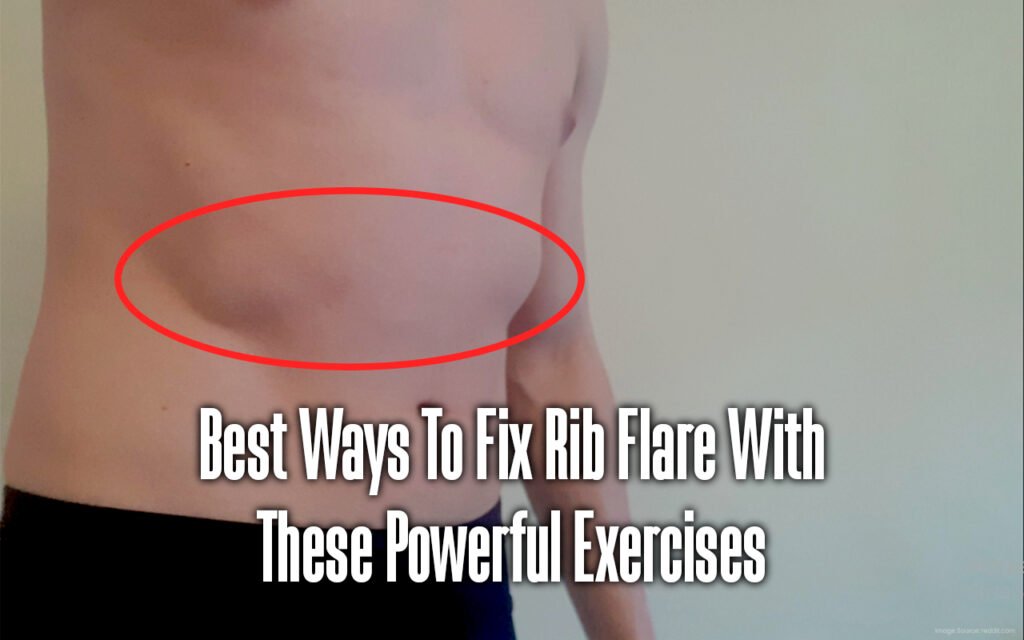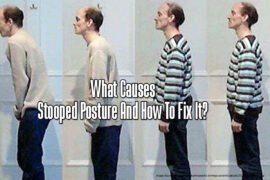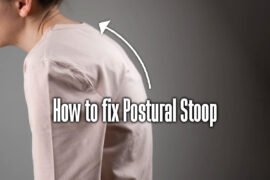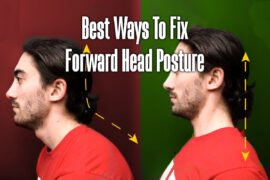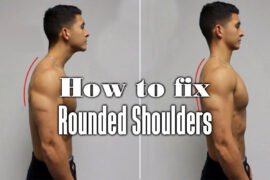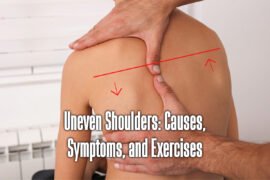What Is Rib Flare?
Table of Contents
In rib flare, the lower ribs rotate externally, causing a slight protrusion of the bottom ribs. Although it’s not a serious issue, it is advisable to address it to avoid potential problems such as back pain, poor posture, and a weakened core. Rib flare can be caused by genetics or prolonged poor breathing patterns. Below, we provide a list of rib flare exercises that you can try in order to improve your condition.
The ribs in our body are not fixed and are actually connected to both the sternum and the thoracic spine. This means that the lower ribs will open up when we inhale and close when we exhale, moving in sync with our breath. The main purpose of the organs in the upper body, like the heart and lungs, is to facilitate the process of breathing and provide protection.
Although rib flare can occur on both sides of the rib cage, it is more frequently observed on the left side because of the presence of larger organs there.
How Rib Flare Occurs?
Shallow breathing is a leading cause of rib flare. This refers to shallow breathing, which involves inhaling air into the upper chest without using the diaphragm. Many people experience shallow breathing due to stress, which can become a habit over time. Therefore, some individuals may need to re-learn how to breathe properly.
Rib flare can be caused by bad posture as well. Rib flaring causes the diaphragm not fully to expand and touch the thoracic wall. Poor posture often leads to a slackening or lengthening of the lower abdominal muscles. Poor posture can cause pelvic tilt, which is an additional complication to consider.
There are many techniques that may be used to improve this condition, which can lead to better breathing habits by enhancing core strength.
Why Is Rib Flare A Problem?
The condition known as rib flare causes excessive pressure on the spine, neck, ribs, and shoulders. The body has a natural response to protect itself when its natural posture changes, leading to strain accumulation. The central nervous system creates protective mechanisms. When muscles tighten up and remain on alert, it causes joints to feel stiff and unusable. Nerves can lose their natural ability to glide around interfaces in the body when they experience tension. This can cause pain and stiffness to develop, which raises the risk of sustaining an acute injury.
Causes Of Rib Flare
There are many causes of rib flare. Some of the most common causes include:
- Poor posture: When you stand or sit with a poor posture, your shoulders are rounded forward, and your chest caves in. This results in unnatural rib positioning and can cause them to flare out.
- Weak abdominal muscles: Abdominal muscles are responsible for helping to keep the rib cage in place. If these muscles are weak, the rib cage can flare out.
- Shallow breathing: You are not using your diaphragm properly when you breathe shallowly. This can cause the rib cage to flare out.
- Stress: Stress can cause the body to tense up, including the muscles around the rib cage. This can lead to rib flare.
- Genetics: Some people are more prone to rib flare due to their genetics.
- Certain medical conditions: Rib flare can be a cause of certain medical conditions, such as asthma, chronic obstructive pulmonary disease (COPD), and Marfan syndrome.
Symptoms Of Rib Flare
The symptoms of rib flare can vary depending on the underlying cause. Some of the most common symptoms include:
- Pain in the chest or upper back
- Difficulty breathing
- Shortness of breath
- Weakness in the upper body
- Poor posture
- Shallow breathing
- Tightness in the muscles around the rib cage
- Chest pain that worsens with activity
- Chest pain that is relieved by rest
If you’re experiencing these symptoms, it is important to see a doctor to determine the underlying cause. Once the cause is known, treatment can be started to correct the problem.
Diagnosis For Rib Flare
Doctors usually detect rib flare by examining you physically and going through your medical records. Your doctor might inquire about the symptoms you are experiencing and their duration.
The healthcare provider will probably touch your lower ribs to check for tenderness or muscle spasms. Sometimes, your doctor might request imaging tests like X-rays or MRI to detect a problematic rib angle. It’s important to consult your doctor if you suspect that you have a rib flare for proper diagnosis and discussion of available treatment options.
Anatomy Of Flared Ribs
Could you explain what is meant by flared ribs? One of the main issues related to rib flare is the displacement of the zone of apposition (ZOA). Having good rib posture means that a portion of the diaphragm extends vertically inside the chest, starting from the lowest ribs and reaching up to the top of the diaphragm located in the abdomen. The ZOA, also called the Zone of Apposition, is crucial as it regulates the diaphragm’s tension.
Flaring the ribs pulls the highest part of the diaphragm into the chest, which results in the loss of the ZOA. This implies that the diaphragm may not function to its full potential, which can make it difficult to maintain proper breathing. Loss of the ZOA leads to activation of the sympathetic nervous system, causing a “flight or fight” response and a chronic stress level increase.
Breathing Strategies That Improve Rib Flare
Specific breathing techniques can positively affect the position of the lower ribcage because breathing causes movement in the ribcage. To improve lower ribcage dynamics, follow this breathing sequence:
- Silent nasal inhale
- Long, slow, and easy exhale
- During exhalation, you should notice your lower abdominal wall getting smaller and moving backward, not necessarily pulling in. At the same time, your lower ribcage should move in a similar direction.
- Maintain the tension in your abs during the exhale, but do not increase it during the next inhale.
Treatment Options For Rib Flare
A rib flare strap can be used to treat mild cases of rib flare condition, while a rib flare brace is recommended for more severe cases in younger patients with flexible chest walls that can be easily repositioned for effective treatment. Committing to specific exercise routines that target and develop core muscle groups, such as the abdominal external oblique muscles, can improve rib flaring.
If you have a rib flare and your chest wall is no longer flexible enough to be corrected with a brace, chest wall resection and reconstruction surgery might be a suitable option for you.
Using Arm Blaster For Rib Flare
An arm blaster is a tool that can help you fix rib flare. You wear a small, U-shaped device around your upper arm. The arm blaster helps to keep your arm in a fixed position, which can help to prevent your ribs from flaring. To use an arm blaster for rib flare, you will need to:
- Begin by wearing the arm blaster around your neck and securing it to your waist.
- Then, stand up straight with your feet shoulder-width apart and your core engaged.
- Place your arms inside the arm blaster and grip the handles.
- Keeping your elbows tucked at your sides, slowly curl the weight up towards your shoulders.
- Hold the weight at the top of the curl for a few seconds before lowering it back down.
- Repeat this movement for several reps, keeping your core engaged and your back straight throughout.
- As your progress continues, you can increase the weight and reps.
- Remember to breathe steadily throughout the exercise and avoid arching your back and swinging the weight.
In addition to using an arm blaster, it’s also important to improve your posture and strengthen your core muscles through other exercises such as planks, bridges, and squats. Combining these exercises with the use of an arm blaster can help correct rib flare and improve overall body composition.
Best Exercises To Fix Ribs Flare
Plank Exercise
The plank is a straightforward exercise that strengthens the core muscles with the weight of your own body. Improving core strength might help fix the problem of rib flare, as a weakened core can contribute to it. The following is the modified version of the standard plank exercise, which utilizes a posterior pelvic tilt to bring the pelvis towards the ribcage.
- Lay down on the floor with your face towards the ground. Then, support yourself with your forearms and toes.
- Ensure that your elbows are positioned directly below your shoulders.
- Make sure your pelvis is in line with your shoulders.
- You are usually in a position where you have overextended yourself.
- Adjust your posture by tucking your chin and pelvis. Keep your upper back slightly rounded, but not excessively.
- Maintain this position for approximately 30 seconds, then repeat it 4 or 5 times.
Arm Raises
The arms raise exercise greatly improves shoulder mobility and range of motion. It can also help improve the anterior delts’ appearance by building lean muscle. However, if you suffer from rib flare, you will probably find that you cannot raise the arms up & overhead without arching the lower back & pushing out the lower ribs. To perform an arm raise without arching the lower back.
- Start by sitting down crossed-legged with your back flat against the wall.
- Keeping your back & head against the wall, slowly start to raise your arms up and keep them straight as you go.
- Hold your core muscles tight throughout & stop once the back of your hands touch a wall.
- Perform 10 to 15 reps.
Depending on your flexibility and mobility, this may not be easy to perform with a full range of motion and proper form. However, you’ll quickly see improvements if you undertake this exercise regularly. Once this becomes easy to execute, you may progress the movement by performing this exercise standing up.
Pilates Scissor
- Please lie down on your back and place your feet flat on the ground.
- Slowly lift your shoulders and head off the ground while inhaling. Make sure to keep your ribs pulled down to prevent them from flaring out.
- While lifting your head and shoulders off the ground, use your hands to hold and stretch each leg as you scissor them up and down. Remember to exhale during the exercise.
- Breathe in a while, pulling your legs back to the starting position. Breathe out while lowering your head and shoulders to the ground.
- Perform the exercise for 10-20 repetitions.
Doorway Lat Stretch
If you see a significant reduction in shoulder pain and rapid improvement in your posture, it is advisable to perform the standing doorway routine daily. Performing this exercise will not only stretch out your lats but also enhance the mobility of your rib cage. Follow these steps to do it.
- Position yourself directly in front of an open doorway.
- Rotate your arm inwards so that your palm faces out, then grab hold of the doorframe.
- Make sure your hand is aligned with your shoulder.
- Move your buttocks backward in a slow manner.
- You will feel a stretch in your lat, and your shoulder will start to drop.
- Hold this posture for approximately 30 seconds and do it 5 times before moving to the opposite side.
Foam Roller Your Lats
The muscles located at the back of the body, known as the latissimus dorsi or lats, frequently experience tightness. The cause may be related to having an improper posture or spending long hours sitting down. When the lats are tight, it can cause the pelvis to pull up since they are attached, which then causes the lumbar spine to extend. This, in turn, may contribute to rib cage flare.
One can use a foam roller to alleviate muscle tension, which is a simple and effective method. Below are the instructions for using a foam roller to loosen tight lats.
- Assume a resting position on an exercise mat while lying on your side.
- Position your arm that is nearest to the ground in front of you for increased stability.
- Place a foam roller on a floor and position it under your arm, slightly below the armpit.
- Engage your core muscles and raise your hips up from the ground.
- Roll the muscles up and down the foam roller in slow motion.
- Avoid rolling down too far where your lower ribcage is, as it can lead to injuries.
- Perform 2 sets of 20 repetitions on each side.
Although the exercise may initially be uncomfortable for individuals with particularly tight lats, it is recommended to persevere as it can improve posture and alleviate symptoms of rib flare over time.
Dead Bug
You can strengthen your core, back, and spine by doing the dead bug exercise, which is a bodyweight exercise performed on the floor. Here’s how to perform the exercise:
- Please lie down on your back.
- Please lift your arms straight up in front of you until they form a 90-degree angle with the ground.
- Begin by lifting your legs, keeping your knees, and bending the hips at a 90-degree angle. This is the position to start from.
- Start bringing your left arm down and straightening it slowly. Simultaneously, bring down your right arm and move it toward the back.
- The limbs should be prevented from touching the ground.
- Return the leg and arm back to the starting position after holding for 5 seconds.
- Now switch your right leg with your left arm and lower them down.
Remember to maintain the position for a minimum of five seconds. When you perform the arm extensions behind your head, alternate between your left and right hand while ensuring that your back remains flat on the ground and your core is braced.
Side-Lying Windmill
- Assume a lying side position with your arms straight, legs extended, and head resting on your arm.
- Lift your upper leg gently and place your foot on the ground in front of you.
- Raise your upper arm towards the ceiling while ensuring that your shoulder blades remain lowered and away from your ears. Rotate your torso and reach your arm towards the floor while exhaling.
- As you reach across your body, open up your ribs. Then, go back to the beginning position and do the same on the other side.
Bird Dog
Bird dog exercise is a great way to strengthen the core muscles and lower back. To perform this exercise, get on your hands & knees with your hands shoulder-width apart & your knees hip-width apart. Extend your right arm and left leg until they are straight and parallel to the ground. Hold this posture for a few seconds, and then lower your arm and leg back down to the ground. Repeat this exercise with your left arm and right leg.
Things To Avoid While Suffering From Rib Flare
Here are some things to avoid while suffering from rib flare:
- Activities that cause pain: If you experience pain when doing certain activities, such as lifting weights or playing sports, avoid those activities until your pain subsides.
- Activities that put pressure on your chest: Activities such as sleeping on your stomach or wearing tight clothing around your chest can put pressure on your ribs and worsen your pain.
- Excessive coughing or sneezing: These activities can cause your ribs to flare up, so try to avoid them if possible.
- Smoking: Smoking can irritate your ribs and make your pain worse.
- Alcohol: Alcohol can weaken your muscles and make your pain worse.
- Self-treatment: It is important to see a doctor if you are experiencing a rib flare. Self-treatment can worsen your pain and delay the diagnosis and treatment of any underlying medical conditions.
- Tight clothing: Avoid wearing tight clothing, especially around your chest and waist, as it can put pressure on your ribs and aggravate your symptoms.
- Strenuous activities: Avoid engaging in strenuous activities such as running, jumping, or other high-impact exercises that can exacerbate your rib flare.
FAQs
Q1. Is rib flare a deformity?
In some cases, even minor cases of pectus excavatum or carinatum can be accompanied by a noticeable rib flaring, which may appear to be the most significant aspect of the deformity. Isolated rib flaring can occur without any other apparent abnormalities.
Q2. Should I see a doctor for a rib flare?
It is important to have a medical professional evaluate any injury to the ribs. It’s recommended that you seek advice for managing the pain and undergo an assessment to determine if there’s any additional damage.
Q3. Why is my rib cage flared on my left side?
The reason for rib flare being more common on the left side is that our internal organs are unevenly distributed, and the diaphragm is not symmetrical. The stomach is situated on the left side and tends to be more flexible compared to the liver, which is located on the right side.
Q4. Will training abs fix rib flare?
Doing countless crunches in every workout may not help correct your rib flare or enhance your Zone of Apposition (ZOA). Try doing the following two exercises with fewer repetitions and focused control to enhance the proper positioning of your ribs and pelvic tilt.
Q5. How long does it take for rib flare to heal?
Rib fractures take more time to heal compared to other types of bone fractures due to the ongoing movement of the ribs. The healing process for a rib fracture can take as long as 12 weeks, but there should be a gradual decrease in pain and improvement in breathing as time goes on.
Q6. What doctor treats rib flares?
If you are experiencing pain while breathing or tenderness in one or more rib areas, it is recommended to schedule an appointment with an orthopedic doctor.
Q7. Do I have flared ribs, or am I just skinny?
Place your thumbs along your ribs at the base of your sternum to determine if you have rib flare due to changes in your rib angle. In order to ensure correct rib positioning, make sure that your thumbs are forming a 90-degree angle. If they are not, it may be an indication that you have an abnormal rib angle.
Q8. Can a corset fix rib flare?
As we have previously discussed, the ribs are a solid bone structure and therefore are unlikely to return to their original position completely if they are fitted with a corset for a longer period. However, soft tissue will eventually tend to expand back to its original shape.
Q9. Is it OK if my ribs are showing?
It’s normal to see your ribcage, but if you’re overall too skinny, you may want to consider gaining some weight to add some flesh to your bones. If you want to build muscle, make sure to eat more and exercise. But remember, being fit is what really matters, so don’t stress if you don’t end up building muscle.
Q10. Does waist training shrink your ribs?
The idea of being able to alter your bone structure is a myth. “As an adult woman, your bones are fully developed and cannot be changed, but they can still be bruised or injured.” Using a waist trainer will not reduce the size of a wide rib cage. It may cause bruising or other negative effects.
Conclusion
Rib flare can disrupt your natural breathing patterns, making it difficult to take deep, grounded breaths. Muscular weakness accompanied by aches and pains can also be a result of the condition. Improving your nervous system function and core strength is the most effective and simple approach to reducing rib flare.
Regular corrective exercises can be helpful if you don’t have severe rib flare. Initially, you may struggle to maintain breathing exercises, but with practice, most of these exercises will become easier and help in reducing rib flare symptoms. These muscular and breathing exercises also provide additional benefits.


